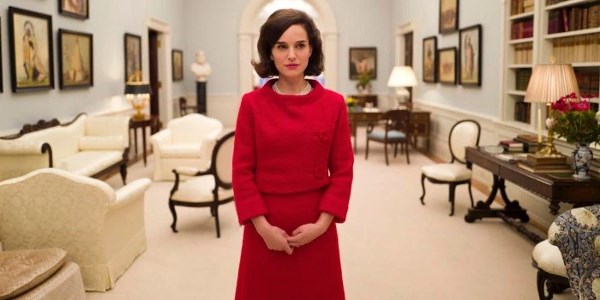Biopics of the Kennedys have largely left a trail of tired conspiracy theories and bad accents in their wake, but in Jackie, Pablo Larrain instead weaves history into the background of a much more intimate portrait of Jackie Kennedy in the days immediately after the death of the president.
The film opens with a meeting between Jackie (Natalie Portman) and a reporter (Billy Crudup) a week after the funeral. The former First Lady is determined to cultivate the Camelot myth, instead of spinning the gory details of the shooting in Dallas. She gives him the real version of what happened while insisting on her own heavily edited account.
Flashbacks to two key timeframes follow: to the 1961 televised tour of the White House, and to the shooting itself and the chaos that followed.
The TV tour was an effort to justify the great expense of Jackie’s renovations of the White House in their first year in office, for which she was highly criticized. The shoot reveals Jackie to be privately nervous, but already cognizant of the best way to soothe the American public.
The hours and days following the shooting are more disjointed. Jackie wipes her husband’s blood off her face on the airplane as she prepares to witness the swearing-in of Lyndon B. Johnson (John Carroll Lynch). She later refuses to take off the soiled pink suit and pillbox hat: “Let them see what they’ve done.” When she finally sheds her clothes and blood-stained hose, she stands in the shower, pink-red water running down her back.
It’s striking how alone Jackie was after the trauma, after having to try to hold her husband’s skull together as they were rushed to the hospital. Yet she wanders the rooms of the White House while the Kennedys try to arrange the funeral against her wishes and the new administration hastens to pack up and move in. Â
Her brother-in-law Bobby (Peter Sarsgaard) appears occasionally to run interference between the family and the Johnsons. (Sarsgaard, having seen too many people butcher the Kennedy accent by overdoing it, takes the opposite tact and emits barely any trace of a Massachusetts accent at all.)
Crudup fares better as the reporter, with whom Jackie is as honest as she is during a meeting with her priest (John Hurt). The reporter is equally blunt: “I can assure you, it was a spectacle,” he says of Jackie’s carefully planned funeral procession through Washington.
“People like to believe in fairy tales,” she correctly states.
The score, by 29-year-old British composer Mica Levi, is up-front, adding to that feeling of disorientation. The film is deliberately short on long tracts of dialogue, and the music fills in the gaps of the Jackie’s first off-kilter days after the death of her husband.
One of the producers is Darren Aronofsky, who may be responsible in part for a tone that is not unlike his film Black Swan (also starring Portman) in the discomfiting darkness both films engender.
The film is a triumph for Portman who expertly captures the loneliness, the resolve and the anguish of a woman forced to grieve in front of millions. “I never wanted fame. I just became a Kennedy.”
Jackie opens Friday at Fifth Avenue.



